

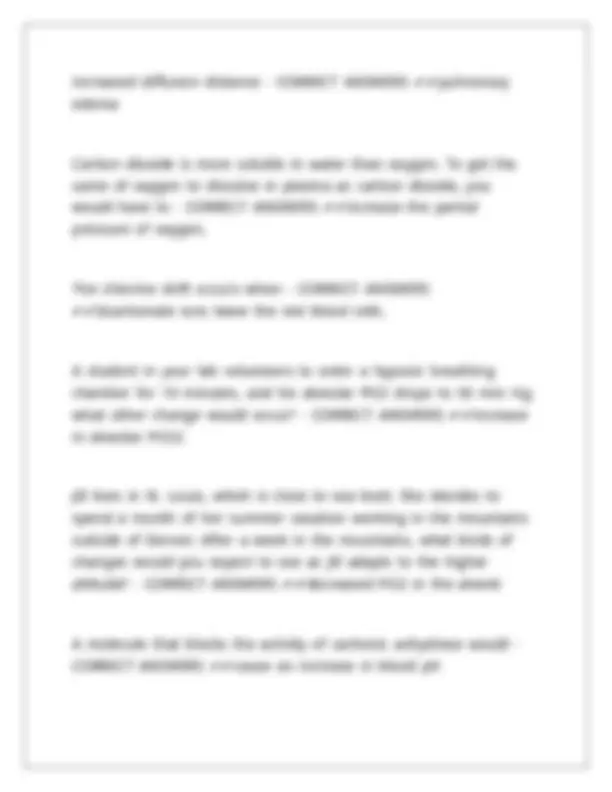
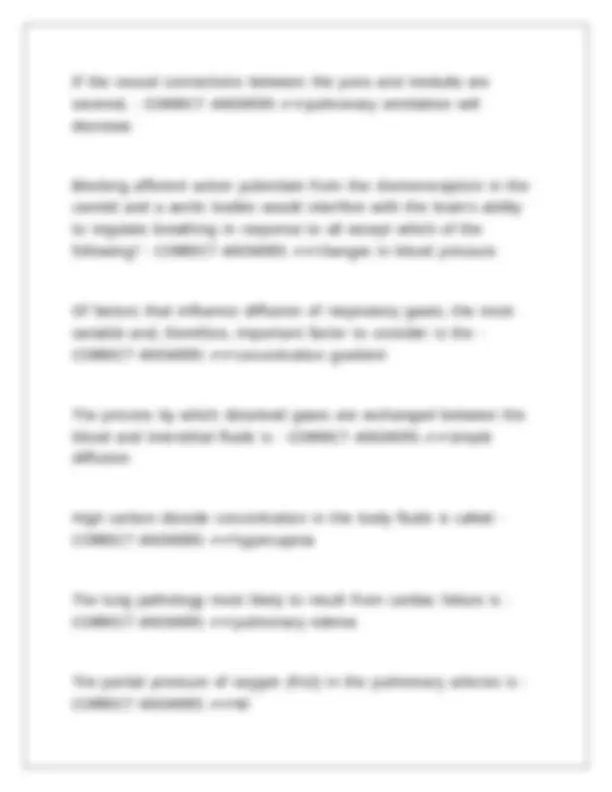
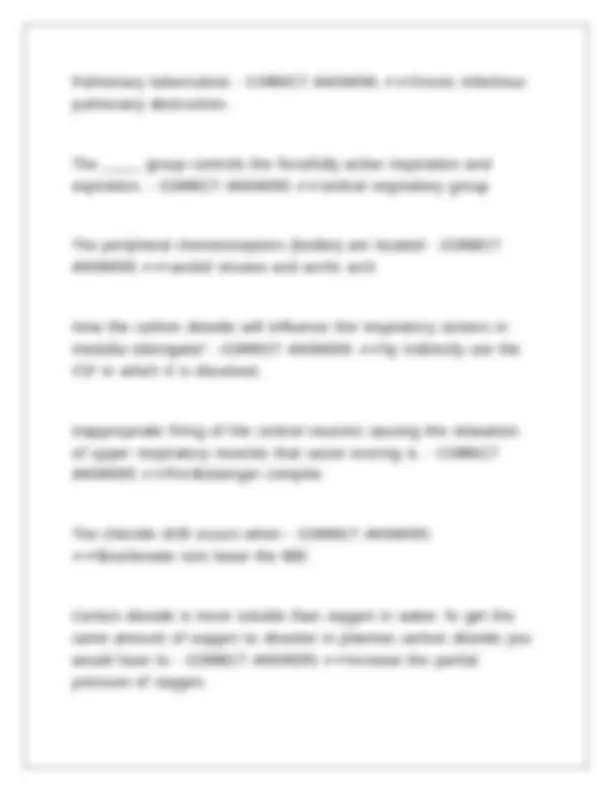
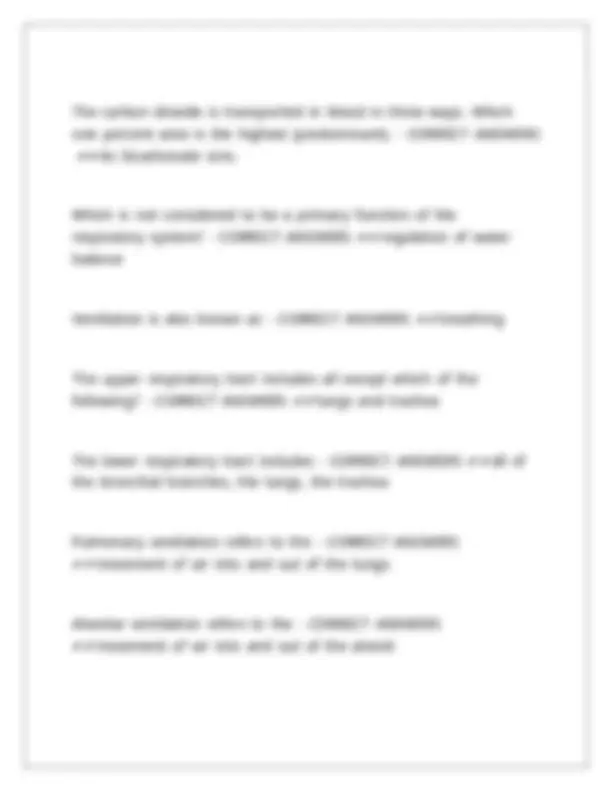
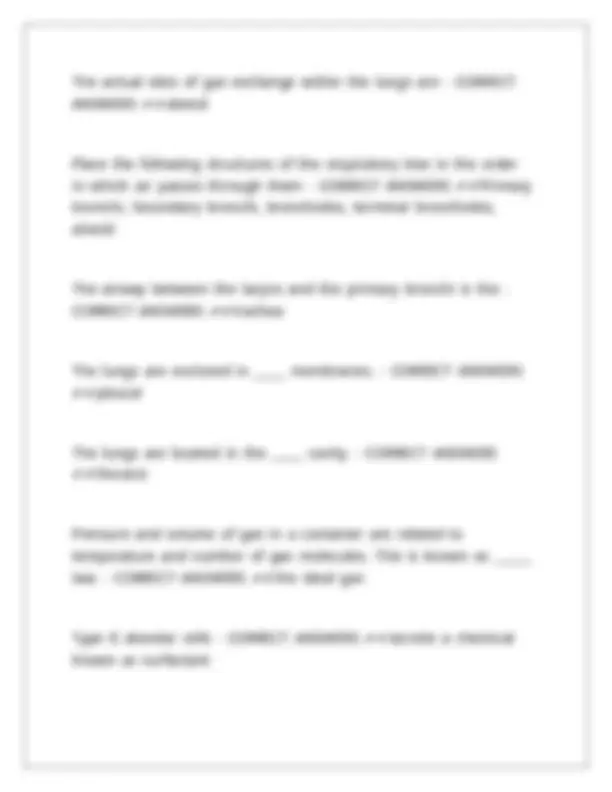
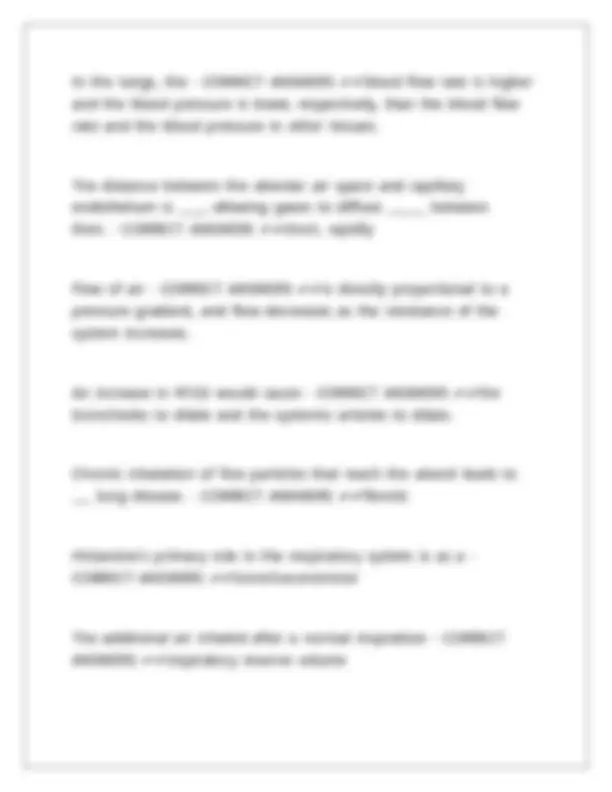
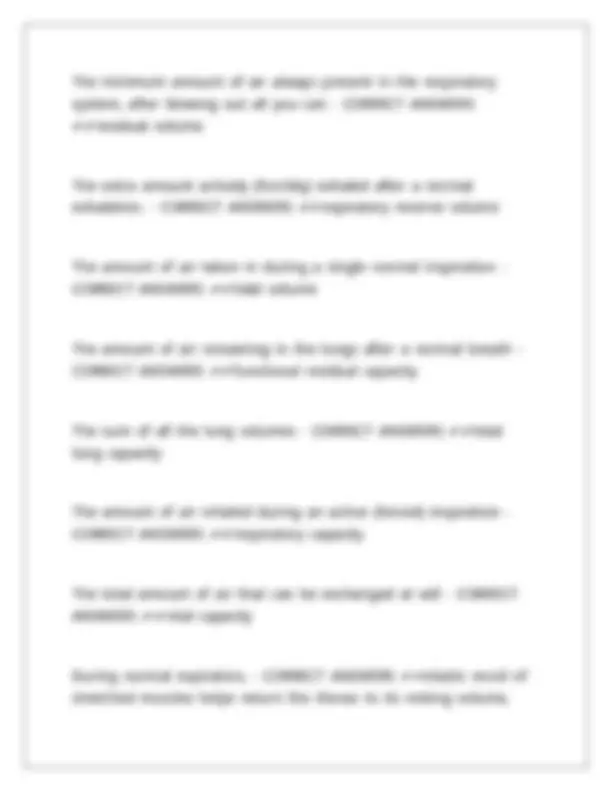
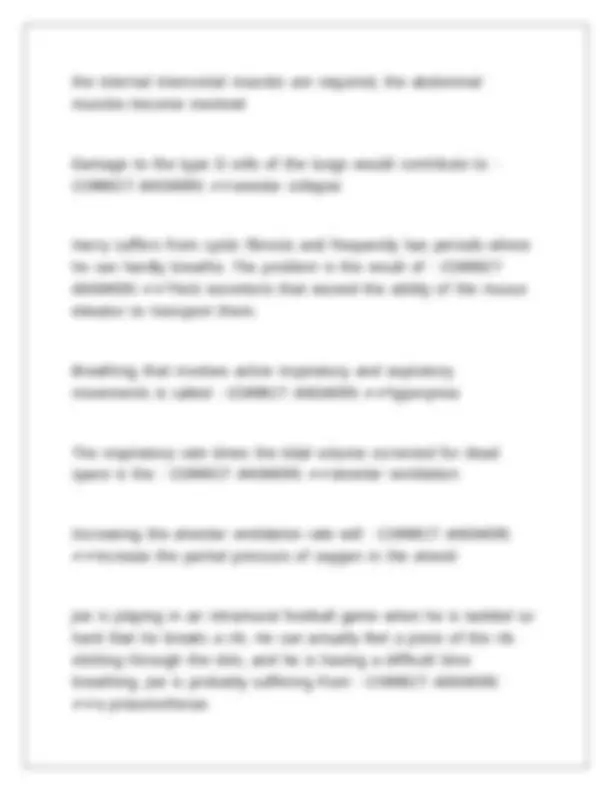
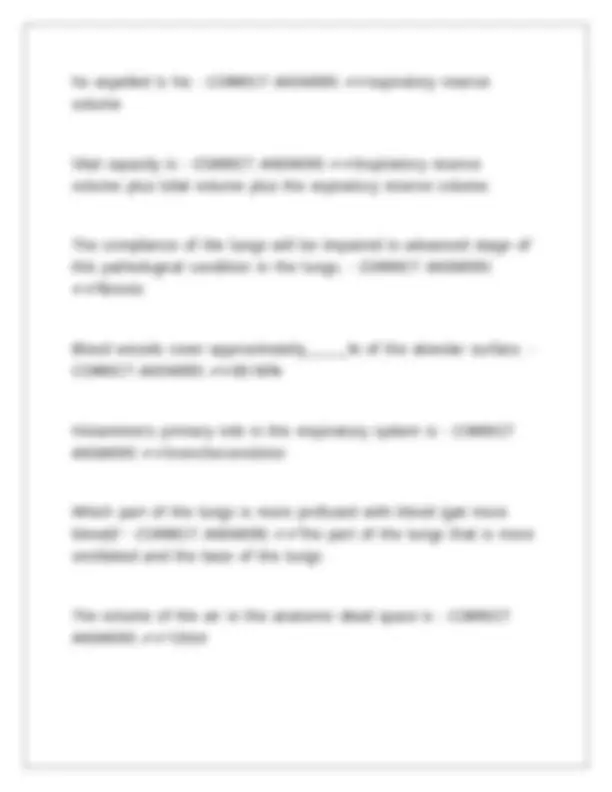
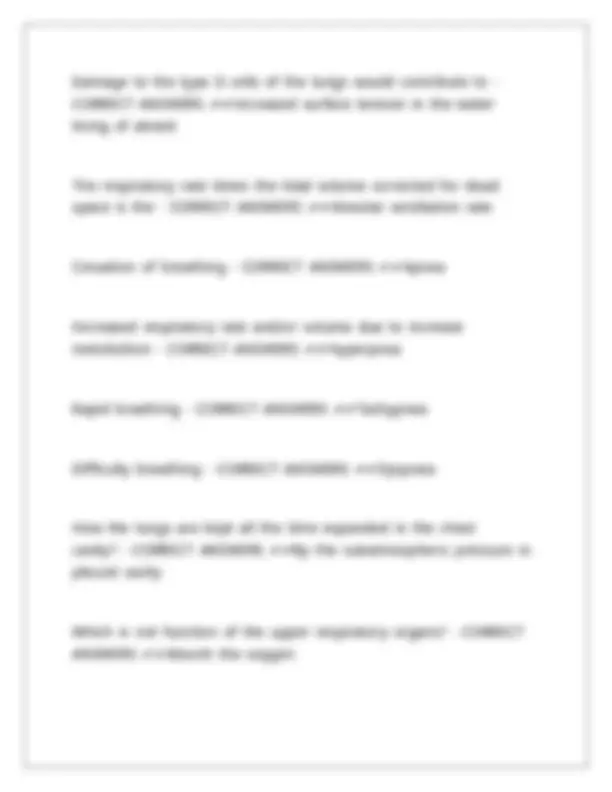
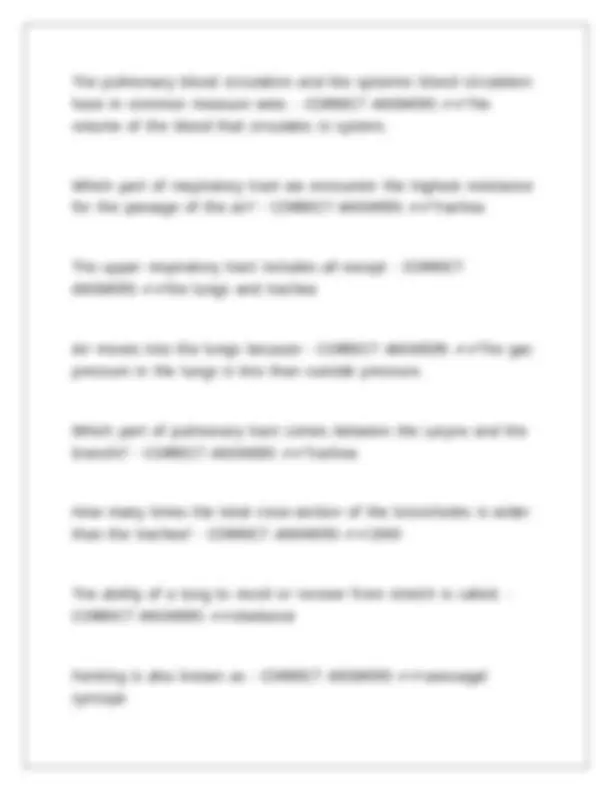
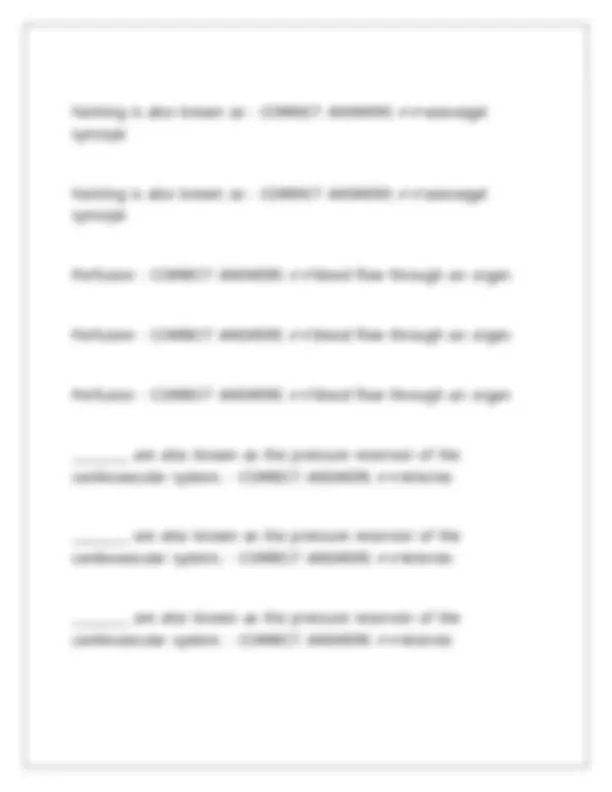
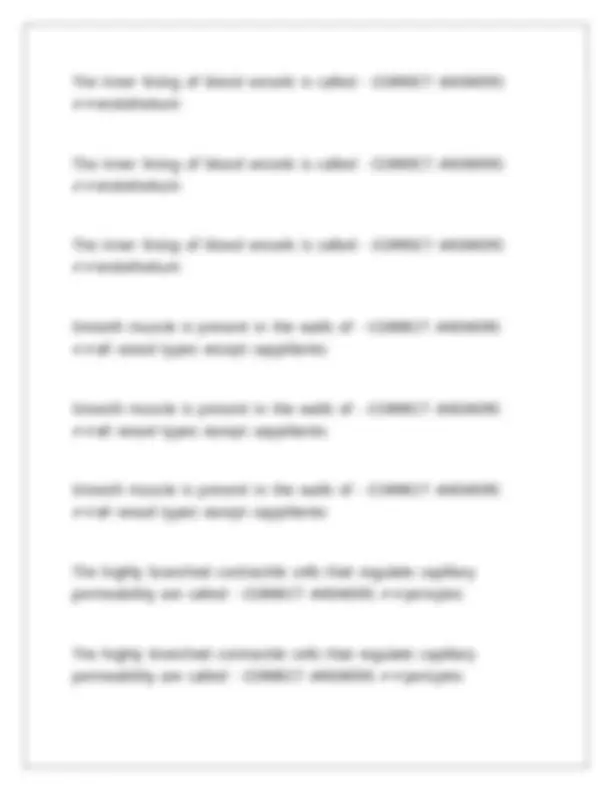
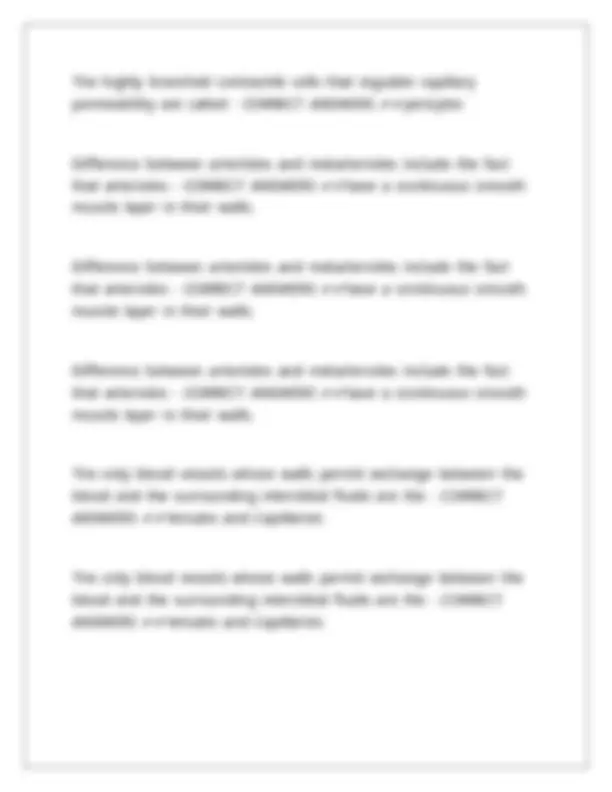
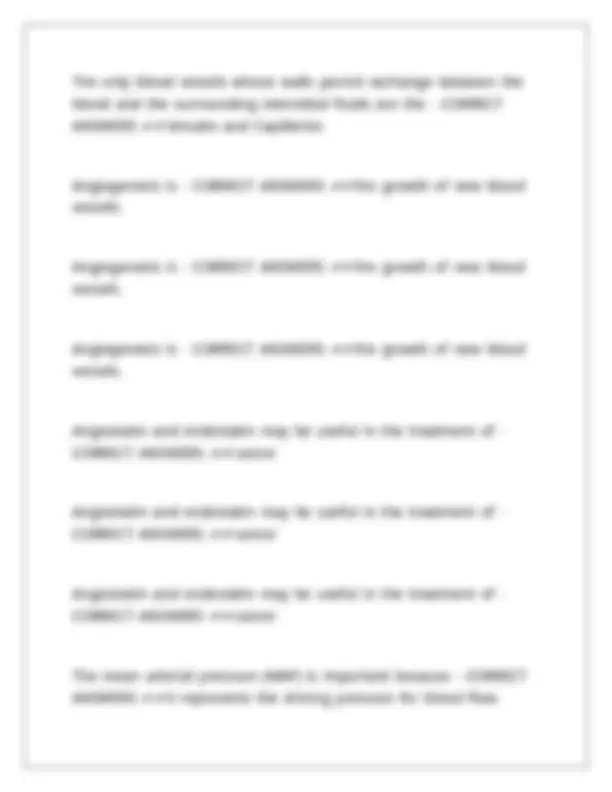
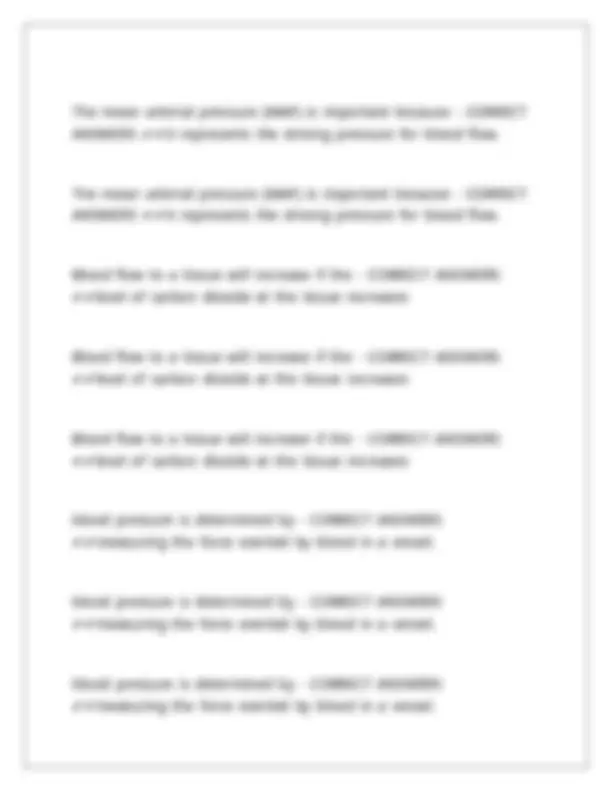
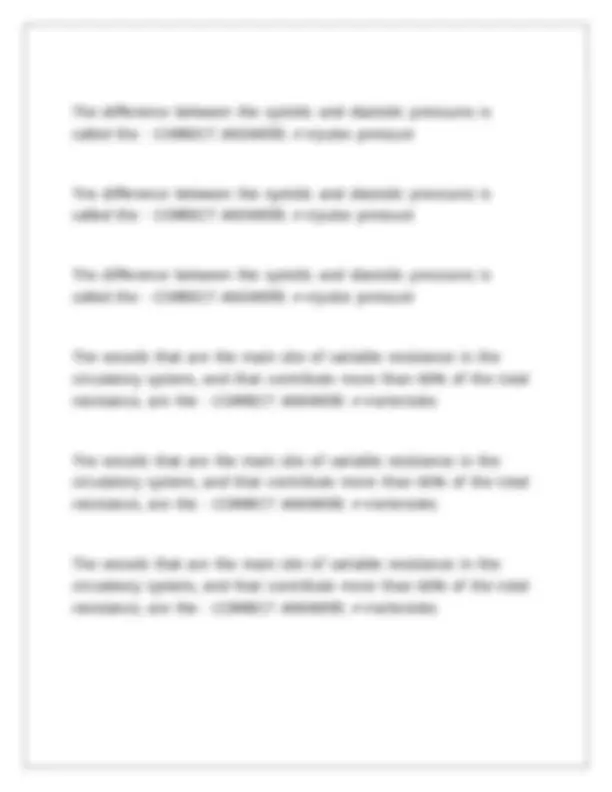
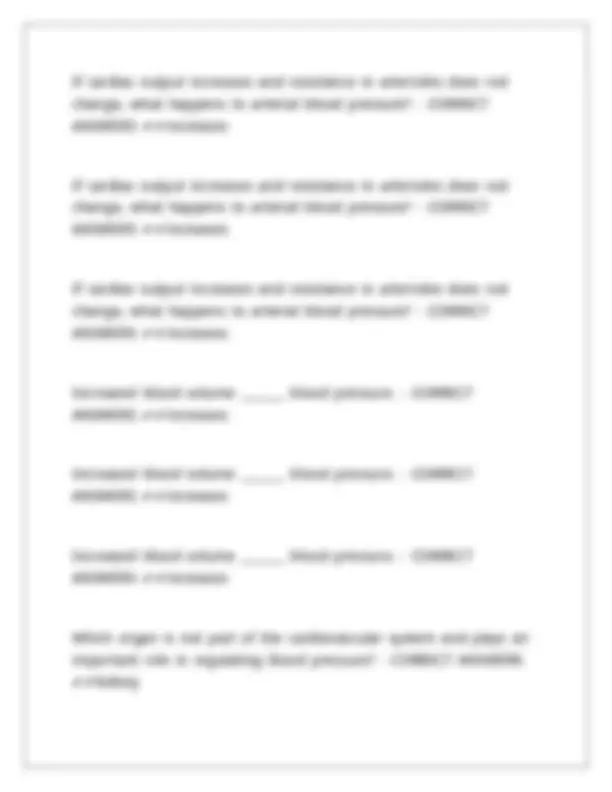
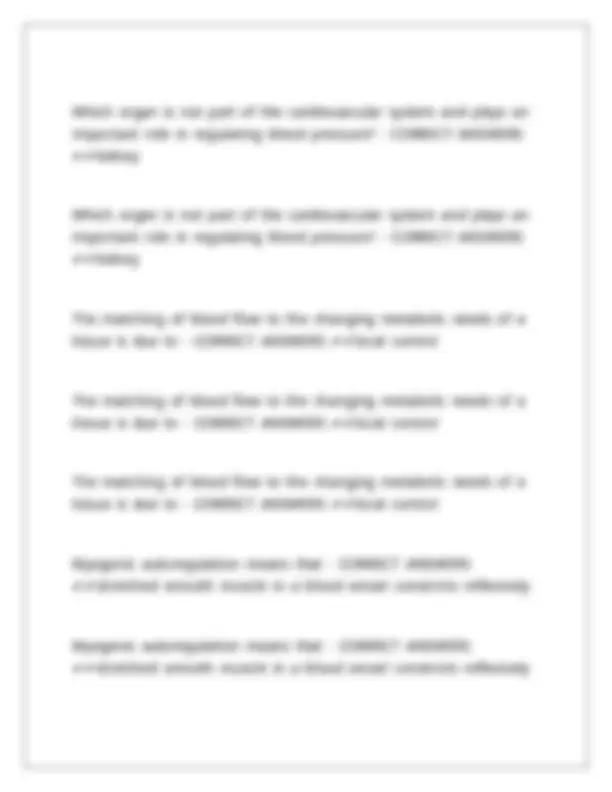
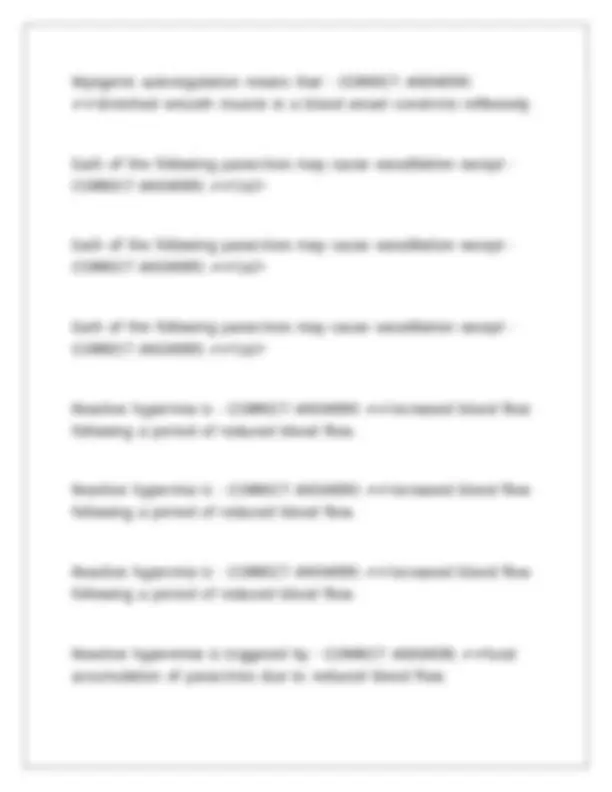
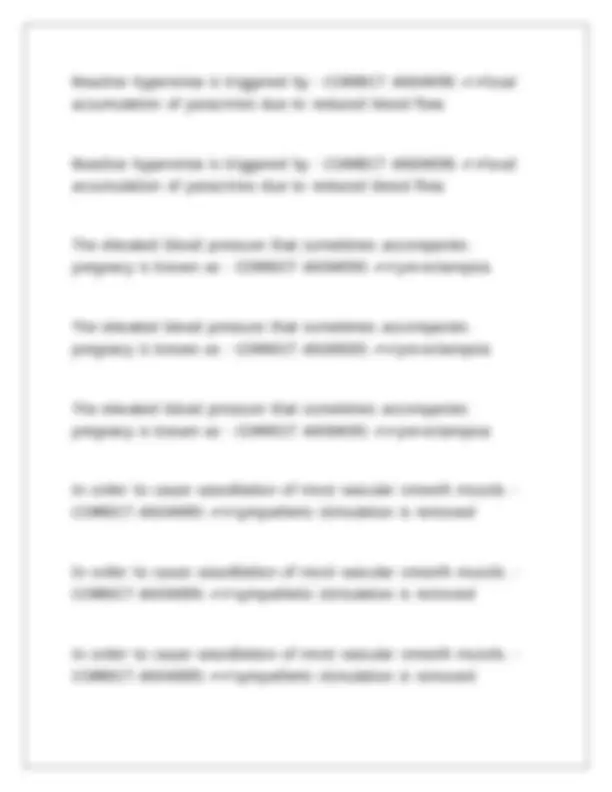
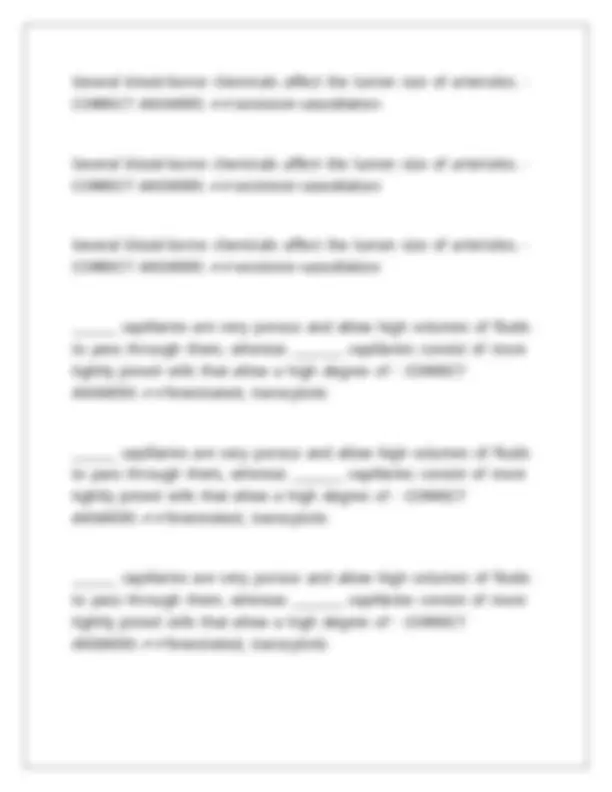
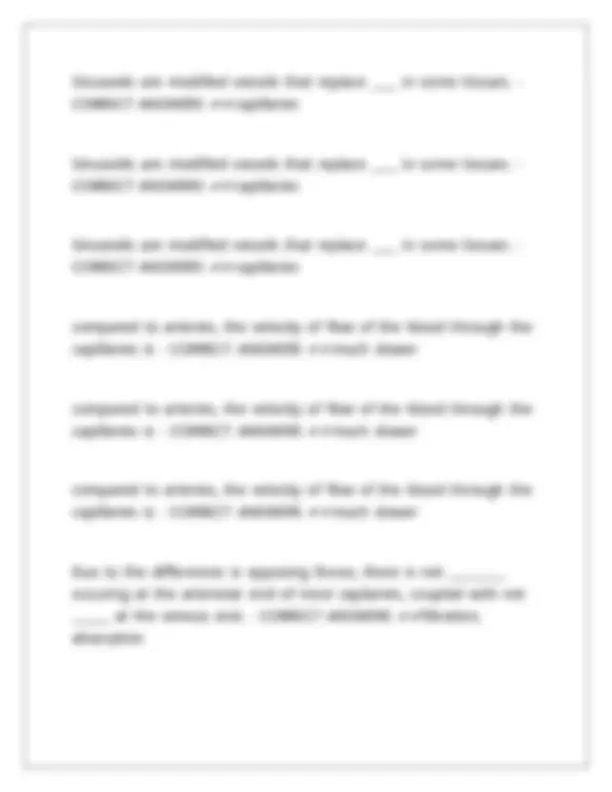
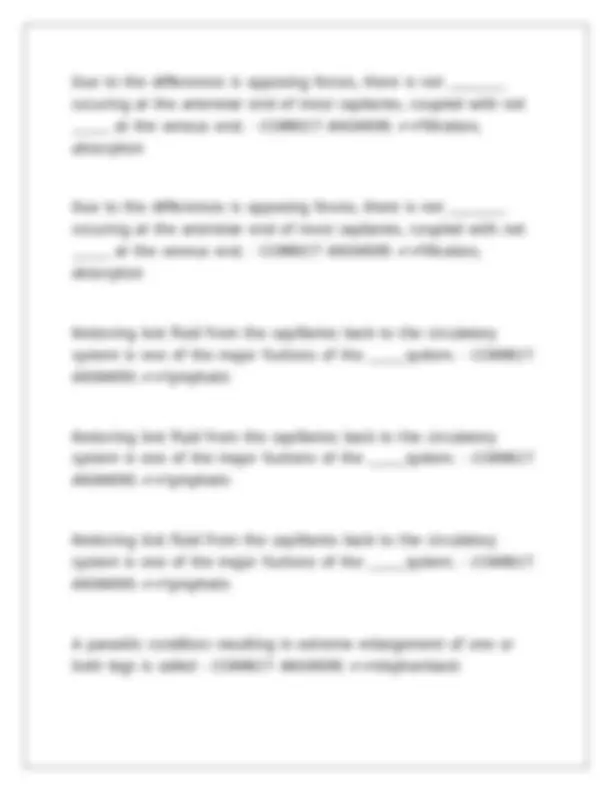
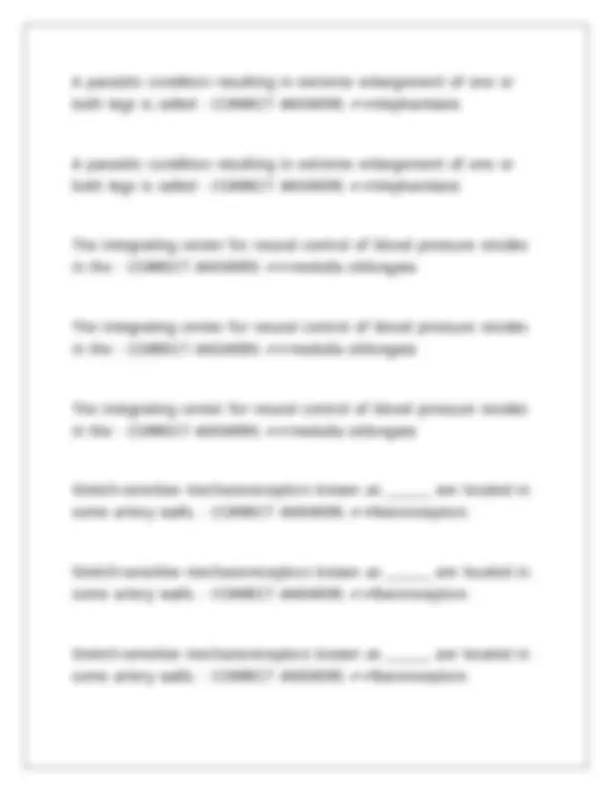
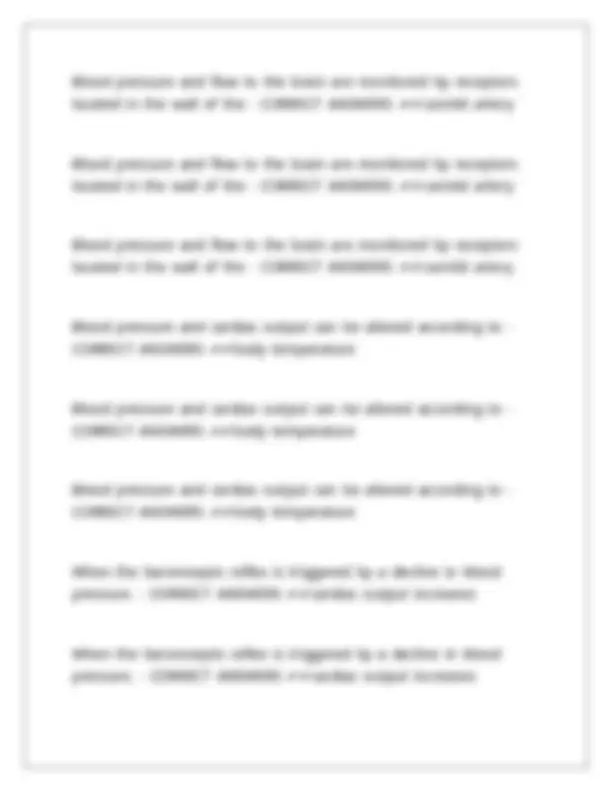
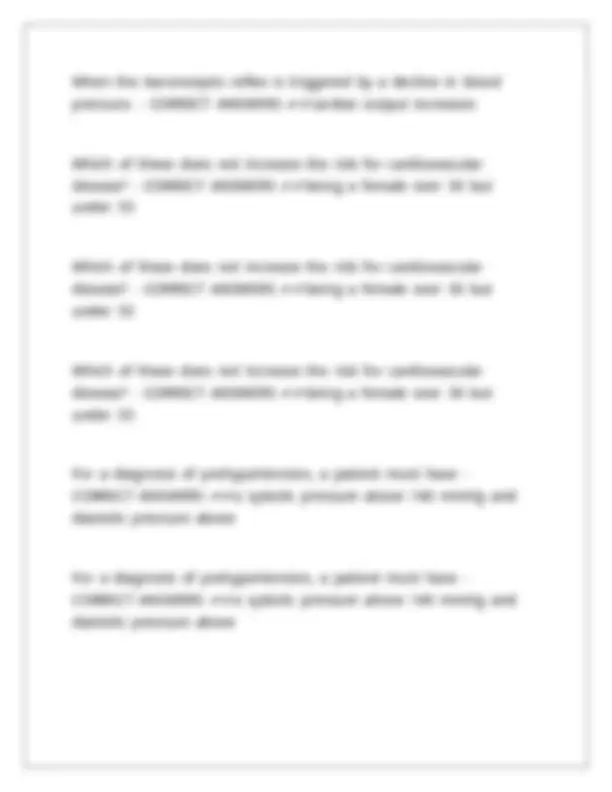
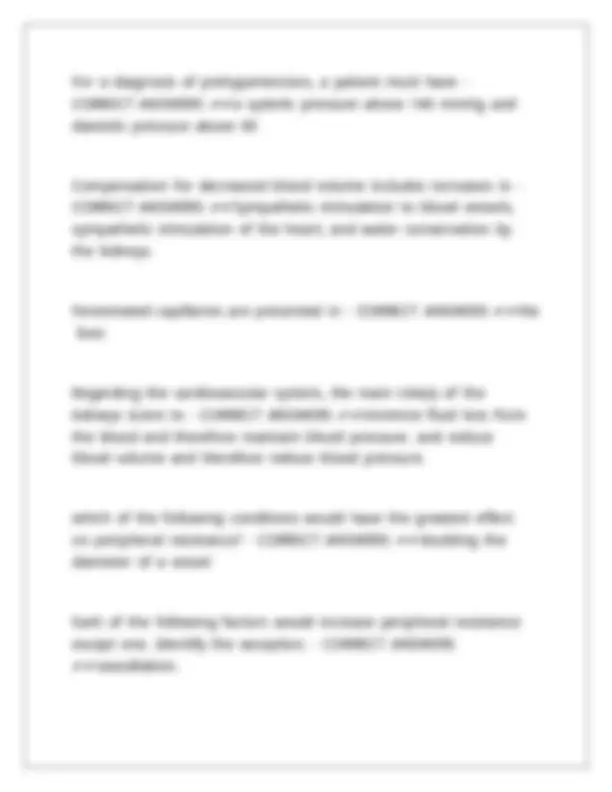
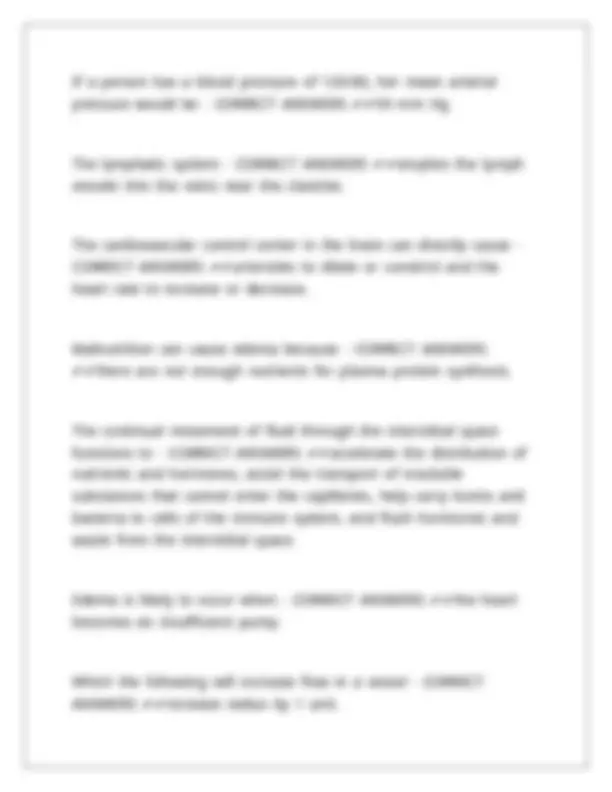
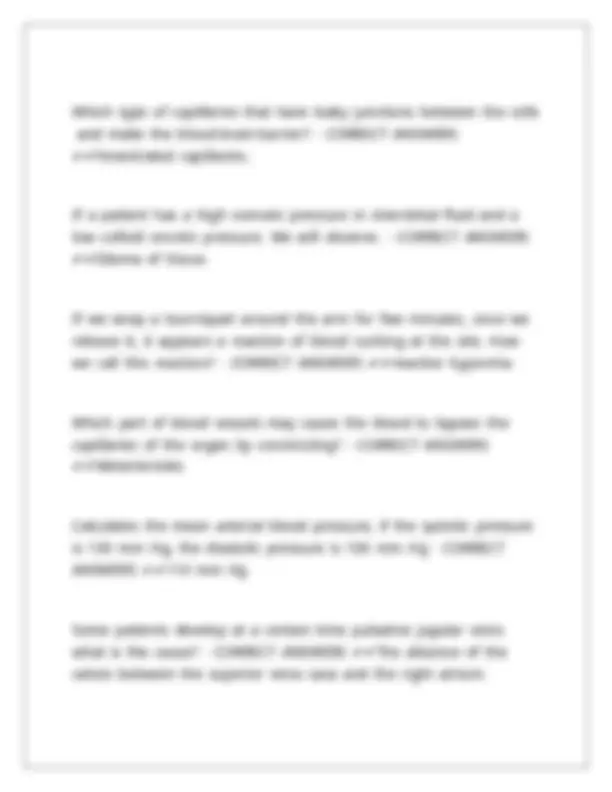
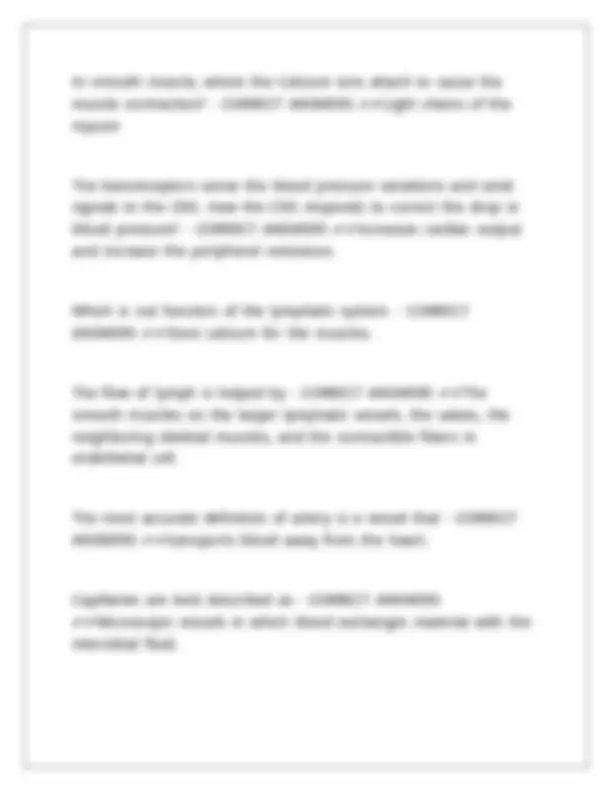
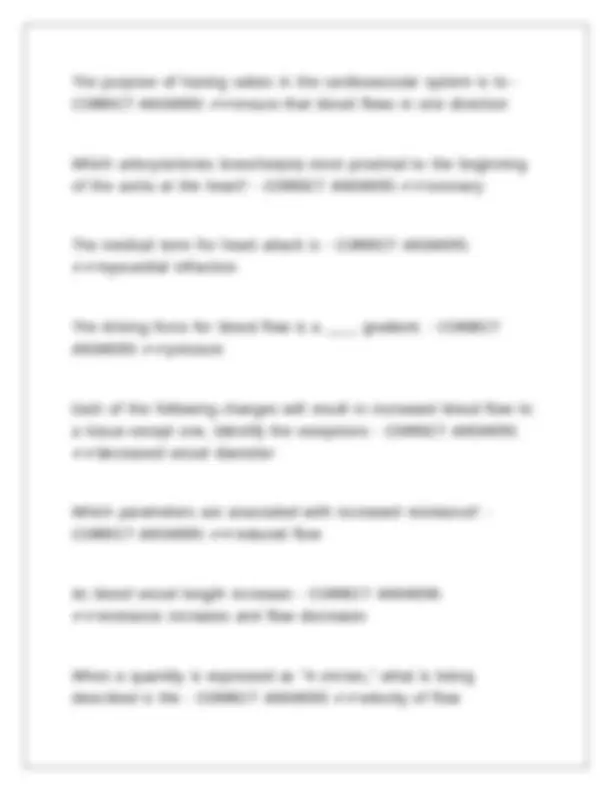
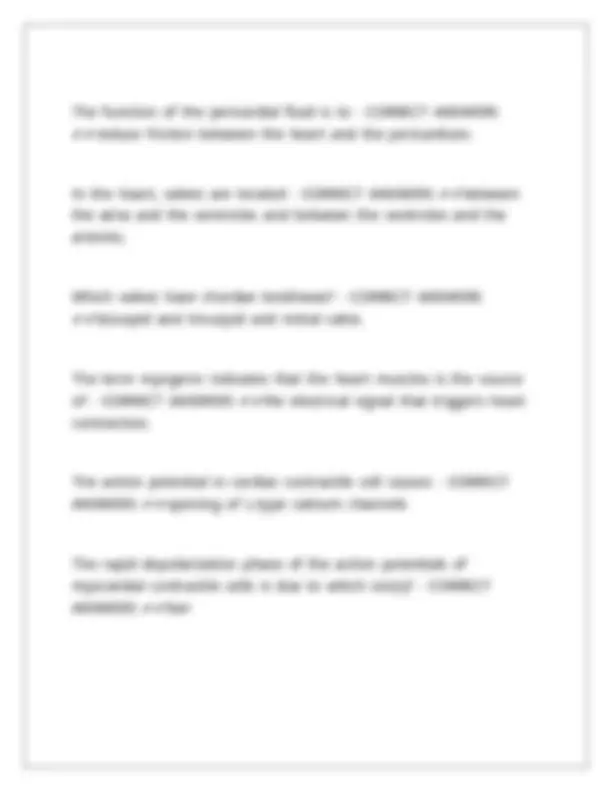
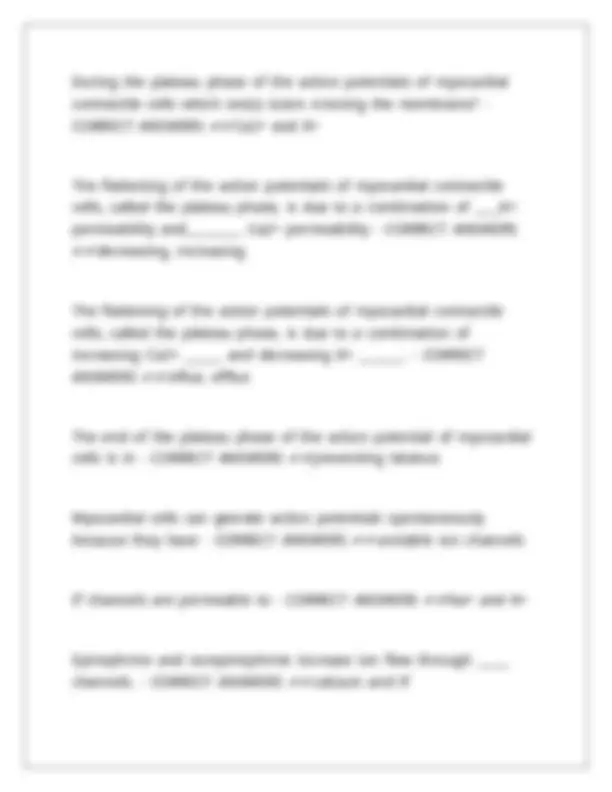
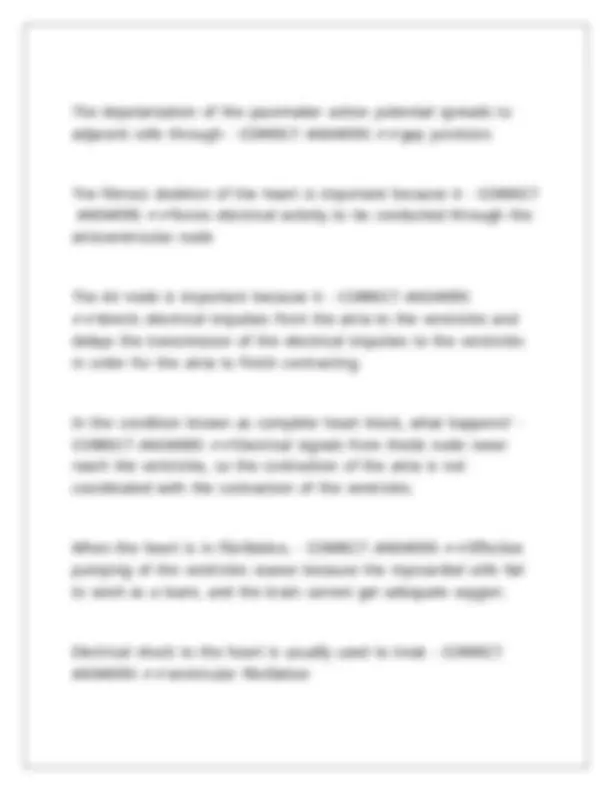
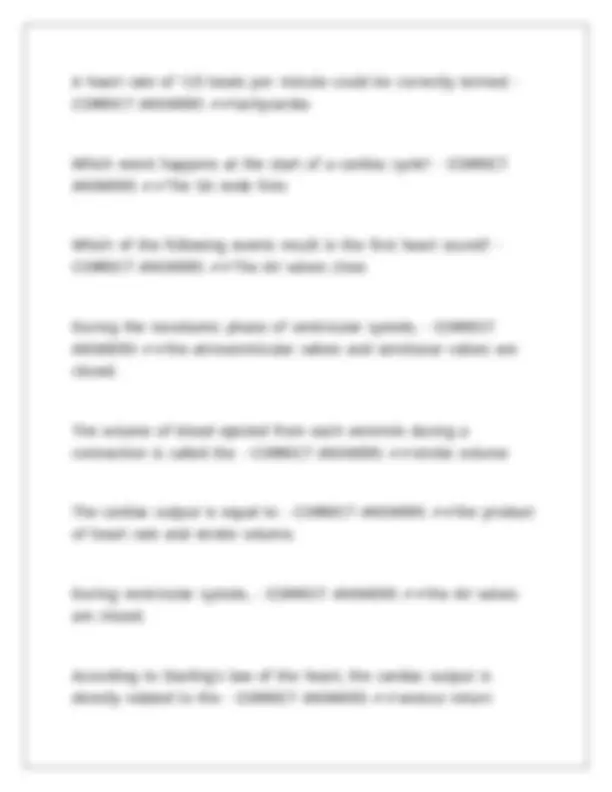
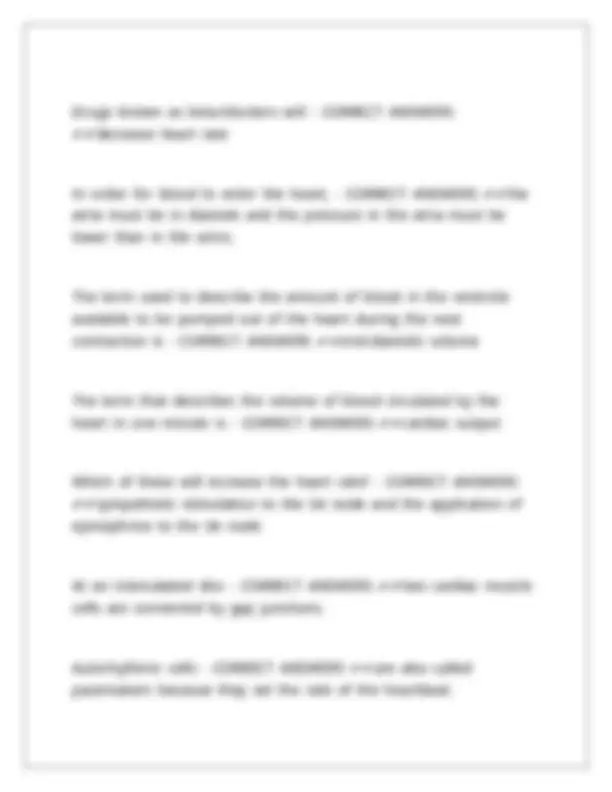
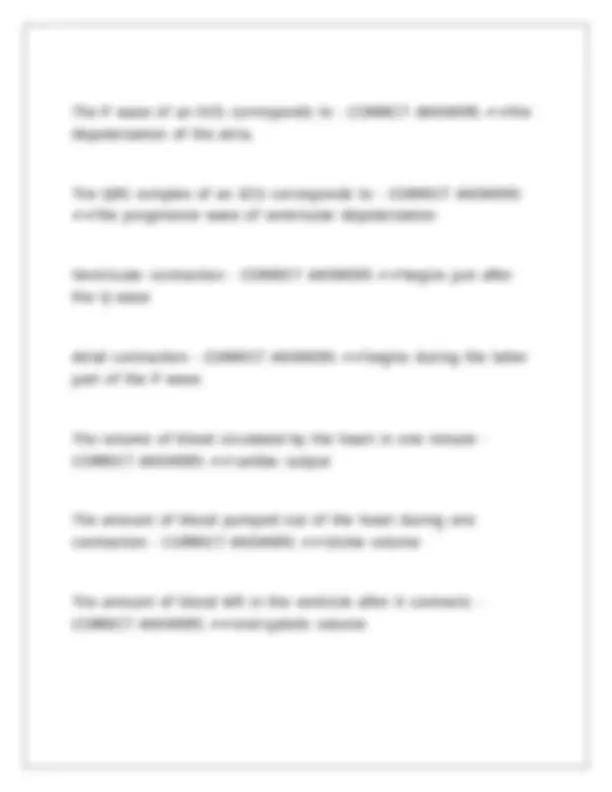
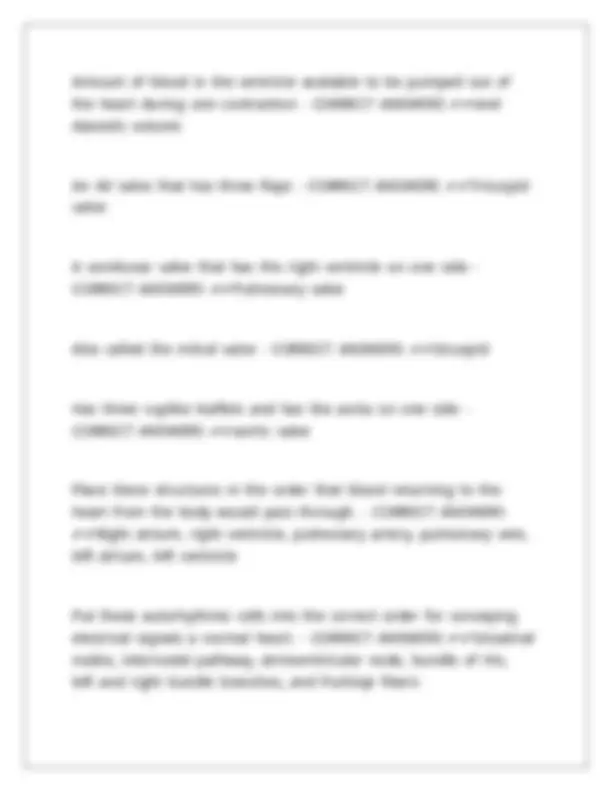
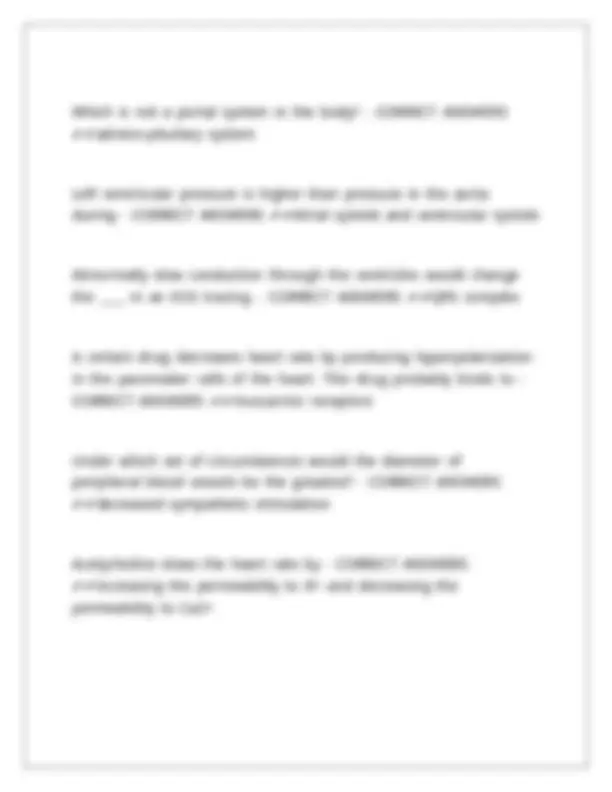
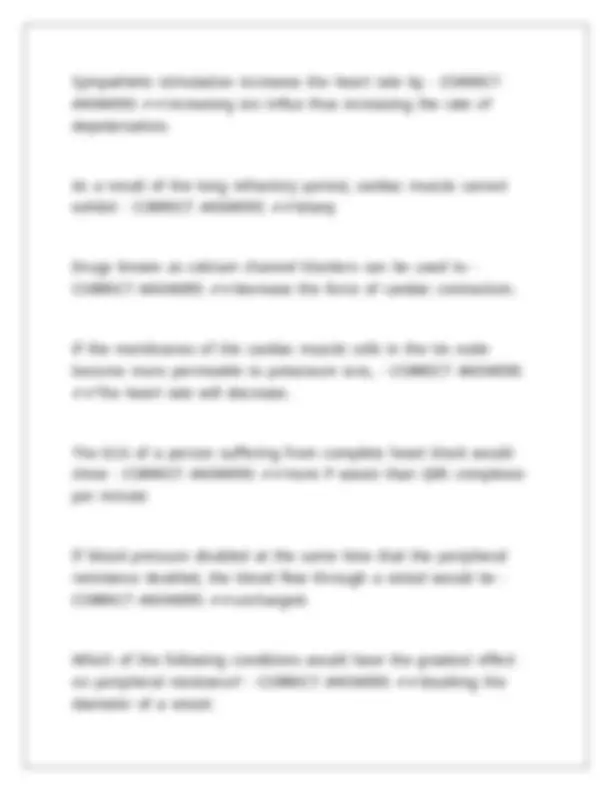
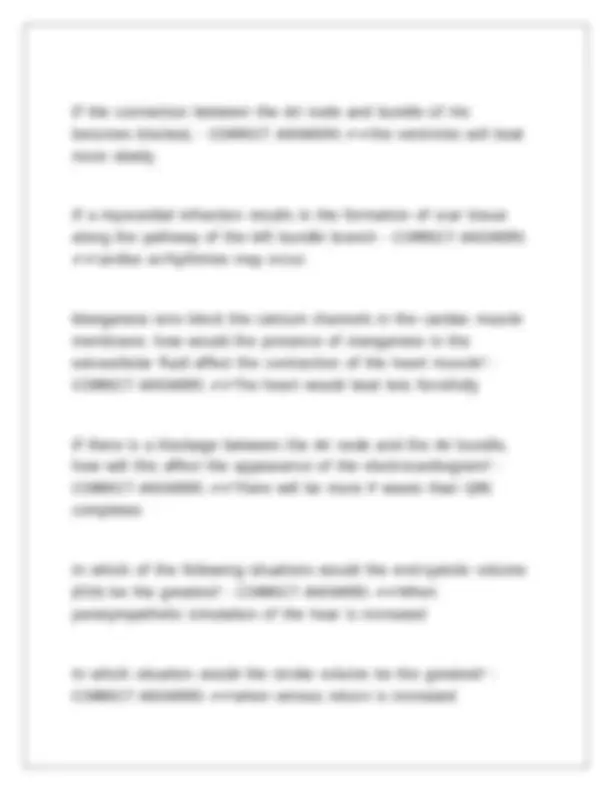



Study with the several resources on Docsity

Earn points by helping other students or get them with a premium plan


Prepare for your exams
Study with the several resources on Docsity

Earn points to download
Earn points by helping other students or get them with a premium plan
Community
Ask the community for help and clear up your study doubts
Discover the best universities in your country according to Docsity users
Free resources
Download our free guides on studying techniques, anxiety management strategies, and thesis advice from Docsity tutors
Gases Exchanges exam questions with answers
Typology: Exams
1 / 52

This page cannot be seen from the preview
Don't miss anything!













































Of |the |factors |that |influence |diffusion |of |respiratory |gases, |the | most |variable |and, |therefore, |important |factor |to |consider |is |the |- | CORRECT |ANSWERS |✔✔concentration |gradient The |process |by |which |dissolved |gases |are |exchanged |between |the | blood |and |interstitial |fluids |is |- |CORRECT |ANSWERS |✔✔diffusion High |carbon |dioxide |concentration |in |body |fluids |is |called |- | CORRECT |ANSWERS |✔✔hypercapnia The |lung |pathology |most |likely |to |result |from |certain |kinds |of | heart |disease |is |- |CORRECT |ANSWERS |✔✔pulmonary |edema The |partial |pressure |of |oxygen |in |arterial |blood |is |approximately | ________ |mmHg. |- |CORRECT |ANSWERS |✔✔ 100 Hypoxia |resulting |from |fluid |accumulation |in |the |alveoli |that | cannot |be |corrected |by |oxygen |therapy |can |lead |to |- |CORRECT | ANSWERS |✔✔adult |respiratory |distress |syndrome
The |partial |pressure |of |carbon |dioxide |in |the |cells |of |peripheral | tissues |is |approximately |_________ |mm |Hg. |- |CORRECT |ANSWERS | ✔✔ 50 Most |of |the |carbon |dioxide |in |the |blood |is |transported |as |- | CORRECT |ANSWERS |✔✔bicarbonate |ions Most |of |the |oxygen |transported |by |the |blood |is |- |CORRECT | ANSWERS |✔✔bound |to |hemoglobin In |the |medulla |oblongata, |the |nucleus |tractus |solitarius |contains |the |________ |of |neurons. |- |CORRECT |ANSWERS |✔✔dorsal |respiratory | group The |most |important |chemical |regulator |of |respiration |is |- |CORRECT | ANSWERS |✔✔carbon |dioxide An |increase |in |the |level |of |carbon |dioxide |in |the |blood |will |- | CORRECT |ANSWERS |✔✔increase |the |rate |of |breathing The |Hering-Breuer |reflex |- |CORRECT |ANSWERS |✔✔prevents |over | expansion |of |the |lungs.
increased |diffusion |distance |- |CORRECT |ANSWERS |✔✔pulmonary | edema Carbon |dioxide |is |more |soluble |in |water |than |oxygen. |To |get |the | same |of |oxygen |to |dissolve |in |plasma |as |carbon |dioxide, |you | would |have |to |- |CORRECT |ANSWERS |✔✔increase |the |partial | pressure |of |oxygen. The |chlorine |shift |occurs |when |- |CORRECT |ANSWERS | ✔✔bicarbonate |ions |leave |the |red |blood |cells. A |student |in |your |lab |volunteers |to |enter |a |hypoxic |breathing | chamber |for | 10 |minutes, |and |his |alveolar |PO2 |drops |to | 50 |mm |Hg. | what |other |change |would |occur? |- |CORRECT |ANSWERS |✔✔increase | in |alveolar |PCO Jill |lives |in |St. |Louis, |which |is |close |to |sea |level. |She |decides |to | spend |a |month |of |her |summer |vacation |working |in |the |mountains | outside |of |Denver. |After |a |week |in |the |mountains, |what |kinds |of | changes |would |you |expect |to |see |as |Jill |adapts |to |the |higher | altitude? |- |CORRECT |ANSWERS |✔✔decreased |PO2 |in |the |alveoli A |molecule |that |blocks |the |activity |of |carbonic |anhydrase |would |- | CORRECT |ANSWERS |✔✔cause |an |increase |in |blood |pH
If |the |neural |connections |between |the |pons |and |medulla |are | severed, |- |CORRECT |ANSWERS |✔✔pulmonary |ventilation |will | decrease Blocking |afferent |action |potentials |from |the |chemoreceptors |in |the | carotid |and |a |aortic |bodies |would |interfere |with |the |brain's |ability | to |regulate |breathing |in |response |to |all |except |which |of |the | following? |- |CORRECT |ANSWERS |✔✔changes |in |blood |pressure Of |factors |that |influence |diffusion |of |respiratory |gases, |the |most | variable |and, |therefore, |important |factor |to |consider |is |the |- | CORRECT |ANSWERS |✔✔concentration |gradient The |process |by |which |dissolved |gases |are |exchanged |between |the | blood |and |interstitial |fluids |is |- |CORRECT |ANSWERS |✔✔simple | diffusion High |carbon |dioxide |concentration |in |the |body |fluids |is |called |- | CORRECT |ANSWERS |✔✔hypercapnia The |lung |pathology |most |likely |to |result |from |cardiac |failure |is |- | CORRECT |ANSWERS |✔✔pulmonary |edema The |partial |pressure |of |oxygen |(Po2) |in |the |pulmonary |arteries |is |- | CORRECT |ANSWERS |✔✔ 40
An |increase |in |the |level |of |CO2 |in |the |blood |will. |- |CORRECT | ANSWERS |✔✔increase |the |rate |of |breathing. The |Hering-Breuer |reflex |- |CORRECT |ANSWERS |✔✔prevents | overexpansion |(overstretching) |of |the |lungs. Protective |reflexes |of |the |lungs |include |- |CORRECT |ANSWERS | ✔✔coughing, |bronchoconstriction, |sneezing, |and |Hering-Breuer | reflex Match |the |lung |disease |to |its |description. |- |CORRECT |ANSWERS | ✔✔... Fibrotic |lung |disease |- |CORRECT |ANSWERS |✔✔Loss |of |pulmonary | elasticity Emphysema |- |CORRECT |ANSWERS |✔✔destruction |of |the |alveoli Asthma |- |CORRECT |ANSWERS |✔✔narrowing |of |the |airways |lumen, | increasing |the |airway |resistance. Pulmonary |edema |- |CORRECT |ANSWERS |✔✔fluid |accumulation |in | the |interstitial |sp[ace |between |alveoli |and |capillaries.
Pulmonary |tuberculosis |- |CORRECT |ANSWERS |✔✔chronic |infectious | pulmonary |destruction. The |______ |group |controls |the |forcefully |active |inspiration |and | expiration. |- |CORRECT |ANSWERS |✔✔ventral |respiratory |group The |peripheral |chemoreceptors |(bodies) |are |located |- |CORRECT | ANSWERS |✔✔carotid |sinuses |and |aortic |arch How |the |carbon |dioxide |will |influence |the |respiratory |centers |in | medulla |oblongata? |- |CORRECT |ANSWERS |✔✔by |indirectly |use |the | CSF |in |which |it |is |dissolved. Inappropriate |firing |of |the |central |neurons |causing |the |relaxation | of |upper |respiratory |muscles |that |cause |snoring |is. |- |CORRECT | ANSWERS |✔✔Pre-Botzenger |complex The |chloride |shift |occurs |when |- |CORRECT |ANSWERS | ✔✔Bicarbonate |ions |leave |the |RBC Carbon |dioxide |is |more |soluble |than |oxygen |in |water. |To |get |the | same |amount |of |oxygen |to |dissolve |in |plasmas |carbon |dioxide |you | would |have |to |- |CORRECT |ANSWERS |✔✔increase |the |partial | pressure |of |oxygen.
The |actual |sites |of |gas |exchange |within |the |lungs |are |- |CORRECT | ANSWERS |✔✔alveoli Place |the |following |structures |of |the |respiratory |tree |in |the |order | in |which |air |passes |through |them |- |CORRECT |ANSWERS |✔✔Primary | bronchi, |Secondary |bronchi, |bronchioles, |terminal |bronchioles, | alveoli The |airway |between |the |larynx |and |the |primary |bronchi |is |the |- | CORRECT |ANSWERS |✔✔trachea The |lungs |are |enclosed |in |_____ |membranes. |- |CORRECT |ANSWERS | ✔✔pleural The |lungs |are |located |in |the |_____ |cavity. |- |CORRECT |ANSWERS | ✔✔thoracic Pressure |and |volume |of |gas |in |a |container |are |related |to | temperature |and |number |of |gas |molecules. |This |is |known |as |______ | law. |- |CORRECT |ANSWERS |✔✔the |ideal |gas Type |II |alveolar |cells |- |CORRECT |ANSWERS |✔✔secrete |a |chemical | known |as |surfactant
Type |I |alveolar |cells |- |CORRECT |ANSWERS |✔✔allow |rapid |diffusion | of |gases |through |their |thin |membranes. Surfactant |- |CORRECT |ANSWERS |✔✔helps |prevent |the |alveoli |from | collapsing The |common |passageway |shared |by |the |respiratory |and |digestive | systems |is |the |- |CORRECT |ANSWERS |✔✔pharynx When |the |diaphragm |and |external |intercostal |muscles |contract, |- | CORRECT |ANSWERS |✔✔the |volume |of |the |thorax |increases Air |moves |into |the |lungs |because |- |CORRECT |ANSWERS |✔✔the |gas | pressure |in |the |lungs |is |less |than |outside |pressure Air |moves |out |of |the |lungs |because |- |CORRECT |ANSWERS |✔✔the | volume |of |the |lungs |decrease |with |expiration. In |quiet |breathing |- |CORRECT |ANSWERS |✔✔inspiration |involves | muscular |contractions |and |expiration |is |passive Boyle's |law |states |that |gas |volume |is |- |CORRECT |ANSWERS | ✔✔inversely |proportional |to |pressure
In |the |lungs, |the |- |CORRECT |ANSWERS |✔✔blood |flow |rate |is |higher | and |the |blood |pressure |is |lower, |respectively, |than |the |blood |flow | rate |and |the |blood |pressure |in |other |tissues. The |distance |between |the |alveolar |air |space |and |capillary | endothelium |is |____, |allowing |gases |to |diffuse |______ |between | then. |- |CORRECT |ANSWERS |✔✔short, |rapidly Flow |of |air |- |CORRECT |ANSWERS |✔✔is |directly |proportional |to |a | pressure |gradient, |and |flow |decreases |as |the |resistance |of |the | system |increases. An |increase |in |PCO2 |would |cause |- |CORRECT |ANSWERS |✔✔the | bronchioles |to |dilate |and |the |systemic |artioles |to |dilate. Chronic |inhalation |of |fine |particles |that |reach |the |alveoli |leads |to | ___ |lung |disease. |- |CORRECT |ANSWERS |✔✔fibrotic Histamine's |primary |role |in |the |respiratory |system |is |as |a |- | CORRECT |ANSWERS |✔✔bronchoconstrictor The |additional |air |inhaled |after |a |normal |inspriation |- |CORRECT | ANSWERS |✔✔inspiratory |reserve |volume
The |minimum |amount |of |air |always |present |in |the |respiratory | system, |after |blowing |out |all |you |can |- |CORRECT |ANSWERS | ✔✔residual |volume The |extra |amount |actively |(forcibly) |exhaled |after |a |normal | exhalation. |- |CORRECT |ANSWERS |✔✔expiratory |reserve |volume The |amount |of |air |taken |in |during |a |single |normal |inspiration |- | CORRECT |ANSWERS |✔✔tidal |volume The |amount |of |air |remaining |in |the |lungs |after |a |normal |breath |- | CORRECT |ANSWERS |✔✔functional |residual |capacity The |sum |of |all |the |lung |volumes |- |CORRECT |ANSWERS |✔✔total | lung |capacity The |amount |of |air |inhaled |during |an |active |(forced) |inspiration |- | CORRECT |ANSWERS |✔✔inspiratory |capacity The |total |amount |of |air |that |can |be |exchanged |at |will |- |CORRECT | ANSWERS |✔✔vital |capacity During |normal |expiration, |- |CORRECT |ANSWERS |✔✔elastic |recoil |of | stretched |muscles |helps |return |the |thorax |to |its |resting |volume, |
In |a |condition |known |as |pleurisy, |there |is |excess |fluid |in |the | pleural |space. |How |would |you |expect |this |to |affect |the |process |of | pulmonary |ventilation? |- |CORRECT |ANSWERS |✔✔Breathing |would | be |labored |and |difficult. Cessation |of |breathing |- |CORRECT |ANSWERS |✔✔Apnea Increased |respiratory |rate |and/or |volume |without |increased | metabolism |- |CORRECT |ANSWERS |✔✔hyperventilation Increased |respiratory |rate |and/or |volume |due |to |increased | metabolism |- |CORRECT |ANSWERS |✔✔Hyperpnea Rapid |breathing |- |CORRECT |ANSWERS |✔✔Tachypnea Difficulty |breathing |- |CORRECT |ANSWERS |✔✔dyspnea Which |is |not |considered |to |be |a |primary |function |of |the | respiratory |system? |- |CORRECT |ANSWERS |✔✔Regulation |of |water | balance Pulmonary |ventilation |refers |to |the |- |CORRECT |ANSWERS | ✔✔movement |of |the |air |into |and |out |of |the |lungs.
The |actual |sites |of |gases |exchange |- |CORRECT |ANSWERS |✔✔Alveoli Type |II |alveolar |cells |- |CORRECT |ANSWERS |✔✔Secrete |a |chemical | known |as |surfactant Surfactant |- |CORRECT |ANSWERS |✔✔Helps |prevent |the |alveoli |from | callapsing When |the |diaphragm |and |external |intercostals |muscles |contract |- | CORRECT |ANSWERS |✔✔The |gas |pressure |in |the |lungs |is |less |than | outside |pressure. In |quiet |breathing |- |CORRECT |ANSWERS |✔✔Inspiration |involves | muscular |contractions |and |expiration |is |passive Total |cross-sectional |area |_____ |with |each |division |of |the |airways. |- | CORRECT |ANSWERS |✔✔increases The |pleural |pressure |is |- |CORRECT |ANSWERS |✔✔sub-atmospheric If |a |student |inhales |as |deeply |as |possible |and |then |blows |the |air | out |until |he |cannot |exhale |any |more, |the |amount |of |the |air |that |
Damage |to |the |type |II |cells |of |the |lungs |would |contribute |to |- | CORRECT |ANSWERS |✔✔increased |surface |tension |in |the |water | lining |of |alveoli The |respiratory |rate |times |the |tidal |volume |corrected |for |dead | space |is |the |- |CORRECT |ANSWERS |✔✔Alveolar |ventilation |rate Cessation |of |breathing |- |CORRECT |ANSWERS |✔✔Apnea Increased |respiratory |rate |and/or |volume |due |to |increase | metobolism |- |CORRECT |ANSWERS |✔✔Hyperpnea Rapid |breathing |- |CORRECT |ANSWERS |✔✔Tachypnea Difficulty |breathing |- |CORRECT |ANSWERS |✔✔Dyspnea How |the |lungs |are |kept |all |the |time |expanded |in |the |chest | cavity? |- |CORRECT |ANSWERS |✔✔By |the |subatmospheric |pressure |in | pleural |cavity Which |is |not |function |of |the |upper |respiratory |organs? |- |CORRECT | ANSWERS |✔✔Absorb |the |oxygen
The |pulmonary |blood |circulation |and |the |systemic |blood |circulation | have |in |common |measure |wise. |- |CORRECT |ANSWERS |✔✔The | volume |of |the |blood |that |circulates |in |system. Which |part |of |respiratory |tract |we |encounter |the |highest |resistance | for |the |passage |of |the |air? |- |CORRECT |ANSWERS |✔✔Trachea The |upper |respiratory |tract |includes |all |except |- |CORRECT | ANSWERS |✔✔the |lungs |and |trachea Air |moves |into |the |lungs |because |- |CORRECT |ANSWERS |✔✔The |gas | pressure |in |the |lungs |is |less |than |outside |pressure. Which |part |of |pulmonary |tract |comes |between |the |Larynx |and |the | branchi? |- |CORRECT |ANSWERS |✔✔Trachea How |many |times |the |total |cross-section |of |the |bronchioles |is |wider | than |the |trachea? |- |CORRECT |ANSWERS |✔✔ 2000 The |ability |of |a |lung |to |recoil |or |recover |from |stretch |is |called. |- | CORRECT |ANSWERS |✔✔elastance Fainting |is |also |known |as |- |CORRECT |ANSWERS |✔✔vasovagal | syncope